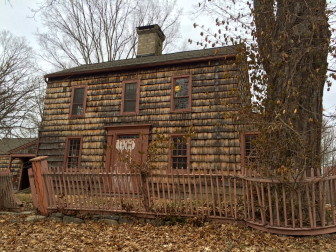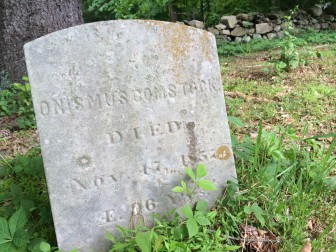Town officials on Wednesday received an application to demolish a Ferris Hill Road home that experts call one of New Canaan’s most historic structures—a development that follows years-long and wide-ranging efforts by its owner and preservationists to save it.

8 Ferris Hill Road in New Canaan. Credit: Michael Dinan
The wood-shingled, 1735-built antique home at 8 Ferris Hill Road (or 441 Canoe Hill Road, according to the assessor, same property) sits in the southwestern corner of a 2.14-acre lot, up against the roadway, as is typical of the era.
Town resident and builder Max Abel acquired the property in November 2013 for $1,250,000 with the thought of building a second home on the lot. It’s a purchase he said that he now regrets “because I held this naïveté that any plan that I would come up with that would include preserving the old house would be very welcome by all the people of the town, including all the neighbors.”

This 7,700-square-foot home once had been planned for a portion of the property at 441 Canoe Hill Road, AKA 8 Ferris Hill Road. Credit: Zillow.com
“And I didn’t see a possibility of anybody objecting to a plan—I could see more demands on how to make a [proposed new] house look more similar [to the antique], or have a garden between [the old and proposed new] houses to connect them, but never envisioned an objection by neighbors.”
The month after he purchased the property, Abel filed an application with the Planning & Zoning Commission for a special permit that would allow the antique home to remain as an accessory structure so that he could build a new house on the property (the combined square footage would go over coverage). Though Abel worked with preservationists and made some concessions in his development plan, several neighbors objected to its specifics, citing safety and aesthetic concerns, and in some cases requesting that P&Z impose requirements regarding the preservation of the antique (thought to have housed Connecticut’s last slave—more on that below), according to P&Z meeting minutes from January and February 2014.

Here’s an online site plan, now abandoned, for 8 Ferris Hill Road/441 Canoe Hill Road. Credit: Zillow.com
Preserving the old house while building a new one was Abel’s initial goal, he said, “and this is why I purchased the property—with the idea that the old house would be preserved and this would be welcome by town residents and this is why I went along and filed for a special permit to build another house on the property while keeping the old house. Unfortunately I realized some resistance from neighbors which made me believe that this is not welcome. So I pulled my special permit [application].”
In stepped a group of historians and preservationists that have come to identify themselves as the “8 Ferris Hill Group.” It includes Janet Lindstrom and Mark Markiewicz of the New Canaan Historical Society, Lesley Cousley and Rose Scott Long of the New Canaan Preservation Alliance, and Tom Nissley, member of the Connecticut Trust for Historic Preservation’s Board of Trustees and Advisor to the New Canaan Preservation Alliance.
According to a letter that the group sent to NewCanaanite.com after receiving news of the demolition permit application (read the letter in full as a PDF at the end of this article), the property at 8 Ferris Hill Road is one of the three oldest in New Canaan.
The home “has had minimal significant alterations making it one of the most important historic structures in our town,” the group said in its letter.
“Mr. Abel appreciated the historic significance of this property from the beginning and underwent appropriate steps to incorporate the structure in his plans for the property. Mr. Abel withdrew his application when threatened with legal action, which was an unfortunate development in this process.”
The group then took up a wide-ranging effort to raise the profile of the historic home and present new options to Abel (see their full letter below).
“It should be noted that Mr. Abel has offered to donate the structure to both the Historical Society and the Preservation Alliance,” the group’s letter said. “Neither group was in a position to accept his most generous offer at that time. Furthermore, relocation of 8 Ferris Hill was deemed a ‘last resort’ due to the significance of this property on the original site and the original structure of its massive original stone chimney base.”

The “Hoyt-Burwell-Morse House” as identified in the “Landmarks of New Canaan” book. This illustration by Edwin Eberman.
Called the “Hoyt-Burwell-Morse House” in 1951’s “Landmarks of New Canaan” book, the structure itself hasn’t been registered on a state or national registry. In “Landmarks,” Edwin Hoyt Bouton identifies the home as one of those built and occupied by the Hoyts as that family moved from Norwalk to newly formed Canaan Parish in the 1730s, on what was called “House Ridge”—basically Canoe Hill Road as it rises from Carter Street, up and over the crest of the ridge, to Laurel Road on the other side. Future occupants are said to include Jonathan Burwell, Ezra Hoyt, Capt. Daniel Hoyt and Gilbert Birdsall (more on him here).

Final resting place of Onesimus Comstock, born into slavery in New Canaan in 1761 and said to be the last living slave in Connecticut. He’s buried at Canoe Hill Cemetery (off of Laurel Road). Credit: Michael Dinan
At least one local historian believes the house to have been occupied by Onesimus Comstock—a man born into slavery in New Canaan in 1761 and said by some to be the last living slave in Connecticut (there’s some debate; he died at 96 in 1857). Comstock had identified himself as “voluntary slave” in the 1850 Census for Norwalk—he’s buried in the nearby Canoe Hill Cemetery (which is off of Laurel). See more history here.
Until about one month ago, Abel said, the home had a tenant. Though he’s not investing in any kind of preservation work “there are taxes to be paid and there is heat to keep on so the piping does not explode from freezing,” Abel said.
The group had proposed one idea to file for a subdivision of the parcel so that .14 acres was cordoned off around the antique, Abel said, while two acres would be allotted to a newly carved parcel for a new home.
“It’s a concept and while I must admit that at this point I have lost hope, I would be glad to go back and revisit the idea if there is a welcoming proposition, especially from neighbors,” he said.
Asked what sort of assurance he would need in order to apply formally for subdivision, Abel said: “To pursue subdivision, I need to bring back my engineer to reassess septic design, bring back my surveyor to consider options for property lines for a subdivision. And most of all, it requires time for this whole process to take its course.”
Meanwhile, the filing of an application to demolish the structure kickstarts a process that could see objections filed.
Under Section 12-9A of the Town Code, an objection letter filed within 15 days following public notice of an Intent To Demolish triggers a review by the town’s Historical Review Committee, which then has 15 days to review the objection.
“If the Committee makes a timely written finding that the structure is of historical, architectural or cultural significance to the Town of New Canaan, then the Building Official shall not issue the demolition permit until 90 days after the date the application was filed. In the event, however, that all pertinent written objections are withdrawn before the expiration of such ninety-day period, or the Committee, having considered the steps that have been taken to accomplish the purpose of this ordinance, makes a finding that no further delay is appropriate, the Building Official shall issue the demolition permit, provided that all other requirements of the State Demolition Code have been satisfied.”
The preservation group said it was encouraged by the creation of a website that Abel developed that’s dedicated to the property and felt “it appeared that the owner would be open to a variety of options for the future of this home.”
New Canaan has many examples of antique homes that have been preserved in various ways, including on Carter Street, Smith Ridge Road and Davenport Ridge Road.
“Those with an interest in acquiring this property should contact Mr. Abel through the 8FerrisHill.com website,” the group’s letter said. “We hope that there may still be a happy resolution to this situation, and that this unique and significant part of New Canaan and Connecticut’s history can remain intact on the corner of Ferris and Canoe Hill as it has for over 250 years. We encourage those with an interest in the preservation of this home to contact the Historical Society at newcanaan.historical@gmail.org.”
This is a very sad for the town and for this lovely home. There are many other design alternatives for this important home that need to be explored such as adding on to it directly and “telescoping” out the back that would continue to preserve the facade but also expand the living spaces. The Carter street house is an excellent example of integrating the past and the present. The facade is preserved and the spaces have been updated and the footprint expanded while keeping the historical integrity intact. It would only require some ingenuity and design. Sadly I don’t think there was ever an intention of preserving this home.
This home is a remarkable example of colonial Connecticut architecture and is an integral part of New Canaan’s history. The outside needs paint, and the fence needs repair, but anyone who has been inside can attest to the wonderful condition of the home, including floorboards, windows, and the fantastic stone fireplace. It would be a tragedy for our town to lose this jewel of a historic home.
Sad. Sounds like a little bitterness on the part of the owner is coming to the fore with this demo permit.
I see nothing offensive or arrogant about the original plan to build on this property. It is preserving and improving the historical integrity of the site, and giving the developer a new house. Seems the developer is sensitive to what the community deems a landmark. He is also a victim of serious over reaction on the part of the various historical & preservation societies.
The owner’s original plan was terrific. It allowed him to build a modern house while maintaining a historical structure intact. The neighbors should be ashamed of themselves.